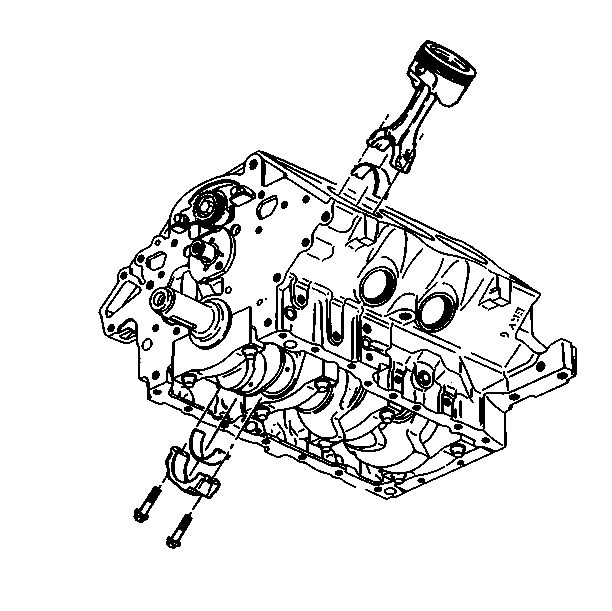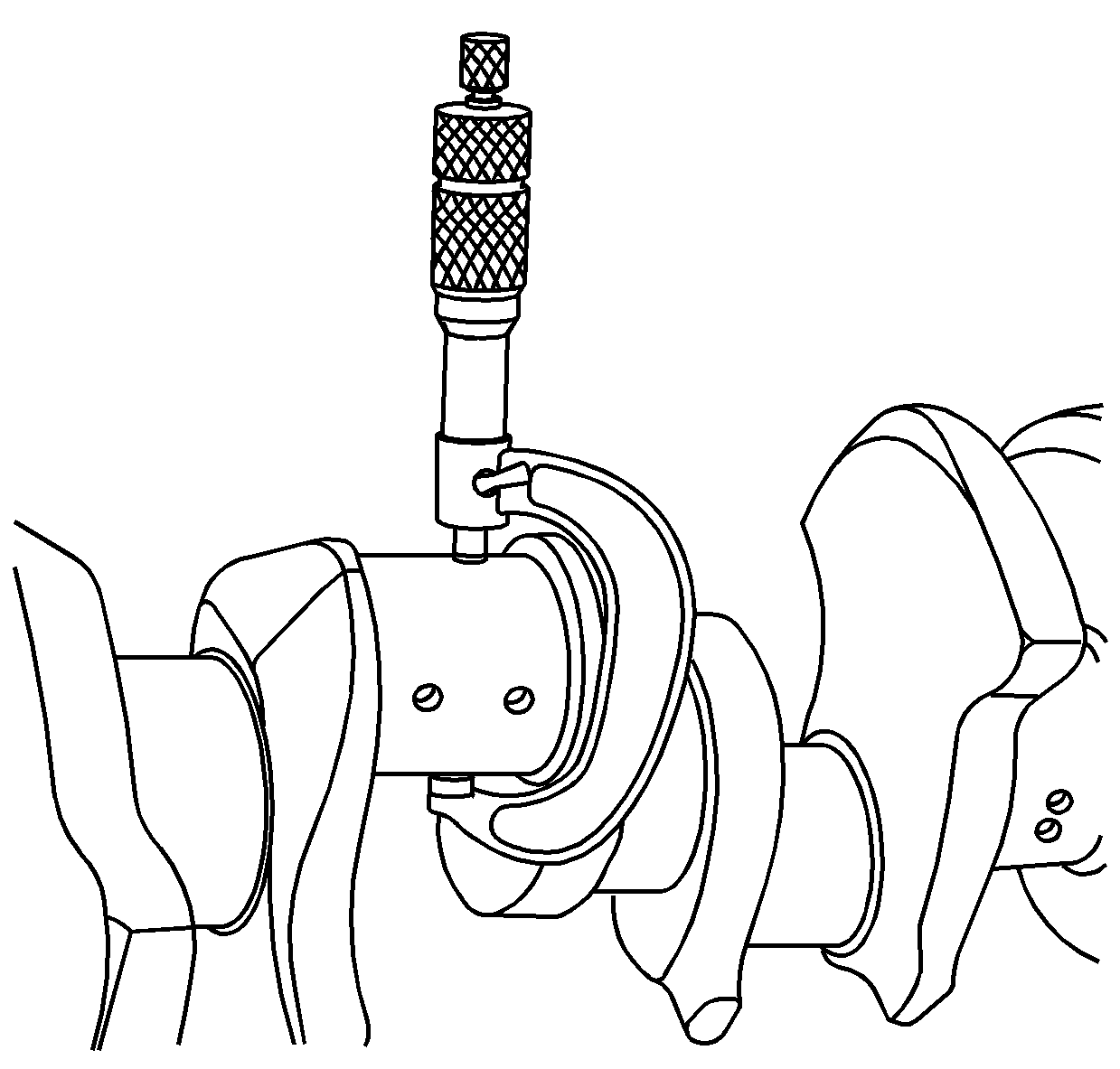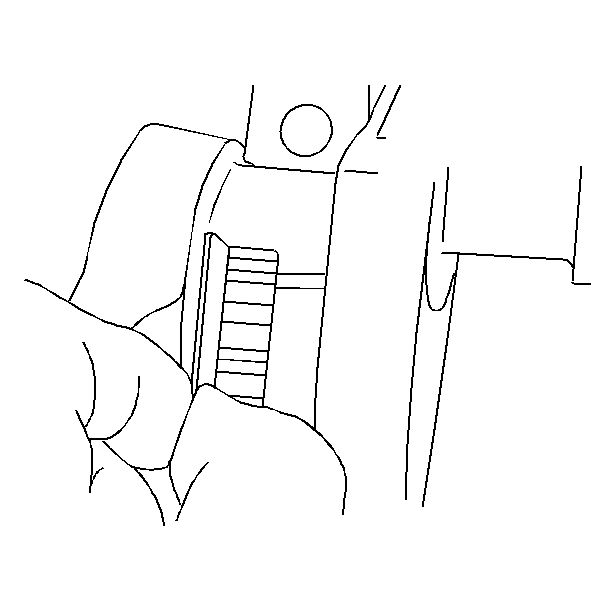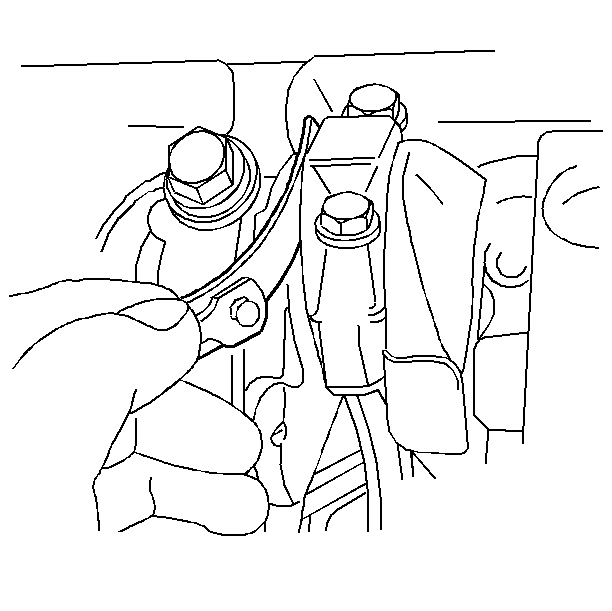Tools Required
J 36660-A Torque Angle Meter
Removal Procedure
- Remove the oil pan. Refer to Oil Pan Replacement .
- Remove the oil pump screen. Refer to Oil Pump Suction Pipe and Screen Assembly Replacement .
- Remove the connecting rod bolts.
- Remove the connecting rod cap and bearings.
- Inspect the bearings for excessive wear or damage.
- Measure the crankpin for out-of-round and taper with a micrometer. If the crankpin is not within specifications, replace or recondition the crankshaft. If installing the new bearings, determine the new bearing size front the maximum crankpin diameter.
- Use the following procedure in order to measure the bearing clearances with gauging plastic:

Important: Place the match marks or numbers on the connecting rods and the connecting rod caps. Connecting rod caps must be assembled to their original connecting rod.
Important: Keep the bearings with their original connecting rod and cap for reassembly. Wipe the oil from the bearings and crankpins.
Important: Connecting rod bearings are a precision insert type and do not use shims for adjustment. Do not file connecting rods or rod caps. If clearances are found to be excessive, a new bearing will be required. Service bearings are available in standard size and also 0.013 and 0.026 mm undersize for use with new and used standard size crankshafts.


Notice: Do not turn the crankshaft assembly after the timing chain has been removed to prevent damage to the piston assemblies or valves.
| 7.1. | Place a piece of gauging plastic the full width of the bearing, parallel to the crankshaft, onto the crankpin. The gauging plastic should be positioned in the middle of the bearing. The bearing is thickest in the center and the bearing clearance must be measured at this location. |
| 7.2. | Install the connecting rod cap with the bearing onto the connecting rod. |
Notice: Use the correct fastener in the correct location. Replacement fasteners must be the correct part number for that application. Fasteners requiring replacement or fasteners requiring the use of thread locking compound or sealant are identified in the service procedure. Do not use paints, lubricants, or corrosion inhibitors on fasteners or fastener joint surfaces unless specified. These coatings affect fastener torque and joint clamping force and may damage the fastener. Use the correct tightening sequence and specifications when installing fasteners in order to avoid damage to parts and systems.
| 7.3. | Install the connecting rod bolts. |
Tighten
Tighten the connecting rod bolts evenly to 27 N·m (20 lb ft).
Use the J 36660-A
in order
to rotate the nuts an additional 50 degrees.
| 7.4. | Remove the connecting rod nuts and cap. The gauging plastic will adhere to either the connecting rod cap or the crankshaft journal, and is measured without removing it. |
| 7.5. | Measure the gauging plastic at its widest, using the scale provided with the gauging plastic. If the clearance is grater than specified, select an undersize bearing and re-measure the clearance. If the clearance cannot be brought to specifications, re-grind the crankpin. If the crankpin is already at the maximum undersize, replace the crankshaft. |
| 7.6. | Remove all the gauging plastic material after measuring. |
Installation Procedure
- Coat the inside surface of the bearings with engine oil.
- Install the connecting rod bearings.
- Install the connecting rod cap.
- Install the connecting rod bolts.
- Use the following procedure in order to measure the connecting rod side clearance:
- Install the oil pump screen. Refer to Oil Pump Suction Pipe and Screen Assembly Replacement .
- Install the oil pan. Refer to Oil Pan Replacement .

Notice: Use the correct fastener in the correct location. Replacement fasteners must be the correct part number for that application. Fasteners requiring replacement or fasteners requiring the use of thread locking compound or sealant are identified in the service procedure. Do not use paints, lubricants, or corrosion inhibitors on fasteners or fastener joint surfaces unless specified. These coatings affect fastener torque and joint clamping force and may damage the fastener. Use the correct tightening sequence and specifications when installing fasteners in order to avoid damage to parts and systems.
Tighten
Tighten the connecting rod bolts to 27 N·m (20 lb ft).
Use the J 36660-A
in order
to rotate the bolts an additional 50 degrees.

| 5.1. | When all of the connecting rod bearings have been installed, tap the connecting rod lightly to the crankpin in order to ensure that the bearings have clearance. |
| 5.2. | Measure the side clearance between the connecting rod caps. Use a feeler gauge or a dial indicator. |
| 5.3. | The rod side clearance should be 0.033-0.079 mm (0.0013-0.0031 in). |
